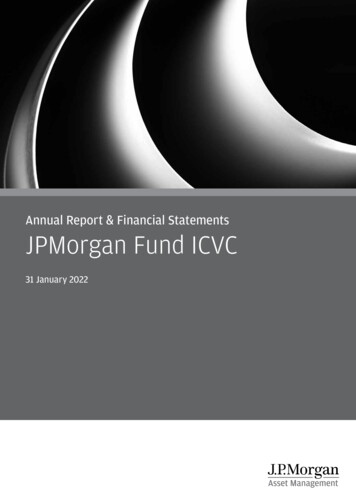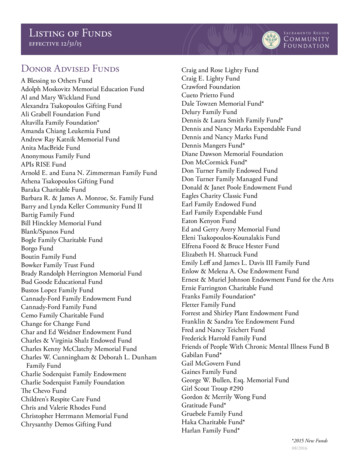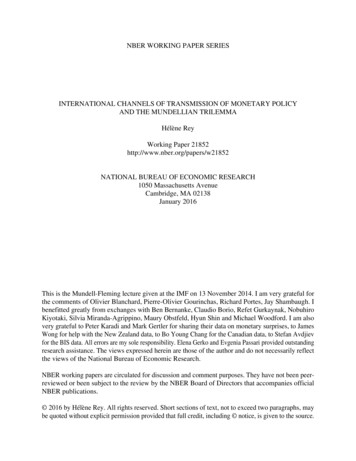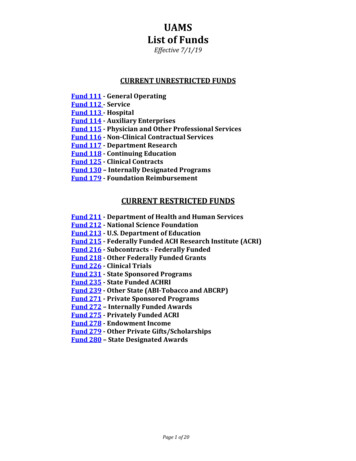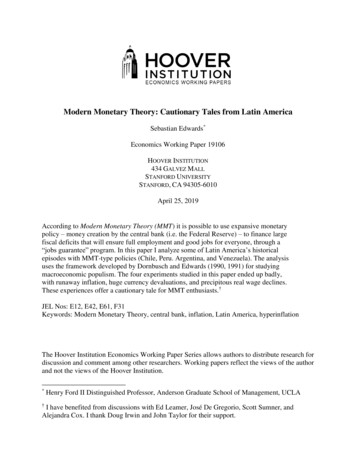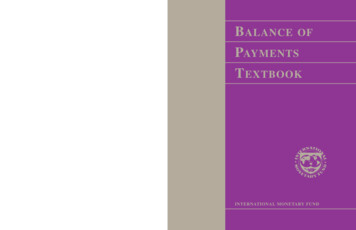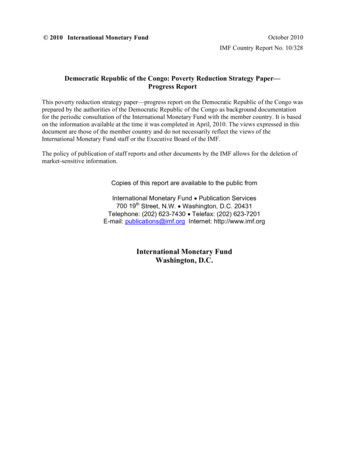
Transcription
October 2010 2010 International Monetary FundJune 16, 2010January 29, 2001IMF Country Report No. 10/328January 29, 2001 January 29, 2001January 29, 2001Democratic Republic of the Congo: Poverty Reduction Strategy Paper—Progress ReportThis poverty reduction strategy paper—progress report on the Democratic Republic of the Congo wasprepared by the authorities of the Democratic Republic of the Congo as background documentationfor the periodic consultation of the International Monetary Fund with the member country. It is basedon the information available at the time it was completed in April, 2010. The views expressed in thisdocument are those of the member country and do not necessarily reflect the views of theInternational Monetary Fund staff or the Executive Board of the IMF.The policy of publication of staff reports and other documents by the IMF allows for the deletion ofmarket-sensitive information.Copies of this report are available to the public fromInternational Monetary Fund Publication Services700 19th Street, N.W. Washington, D.C. 20431Telephone: (202) 623-7430 Telefax: (202) 623-7201E-mail: publications@imf.org Internet: http://www.imf.orgInternational Monetary FundWashington, D.C.
Democratic Republic of the CongoInter-Ministerial Commission on Implementation of the National Poverty Reduction StrategyCI-SNLCPREPORT ON IMPLEMENTATION OF THE GROWTHAND POVERTY REDUCTION STRATEGYApril 2010
TABLE OF CONTENTSTABLE OF CONTENTS .2ACRONYMS.4EXECUTIVE SUMMARY .7CONTEXT SURROUNDING THE PREPARATION AND IMPLEMENTATION OF THE FINAL GPRSP . 14REPORT METHODOLOGY. 15FRAMEWORK . 15CHAPTER 1.ANALYSIS OF MACROECONOMIC PERFORMANCE AND EXPENDITURE. 17INTRODUCTION . 171.1. RECENT DEVELOPMENTS IN THE CONGOLESE ECONOMY . 171.1.1.Economic activity and prices . 171.1.2.Public sector . 171.1.3.External sector . 181.1.4.Monetary sector . 181.1.5.Economic situation at end-March 2010. 181.2.EXPENDITURE ANALYSIS . 201.2.1.Analysis of budget expenditure by category . 201.2.2.Public expenditure in relation to GPRSP priorities . 211.3.MEDIUM-TERM MACROECONOMIC PROSPECTS . 24CHAPTER 2.ACTIONS IMPLEMENTED . 25INTRODUCTION . 252.1.PROMOTING GOOD GOVERNANCE AND CONSOLIDATING PEACE THROUGH STRENGTHENEDINSTITUTIONS . 252.1.1.Security and judicial governance . 252.1.2.Political and administrative governance . 272.1.3.Economic governance . 282.2.POLICIES SUPPORTING ECONOMIC GROWTH . 312.2.1.Agriculture and rural development . 312.2.2.Forest and the environment. 322.2.3.Mines and hydrocarbons . 332.2.4.Energy . 342.2.5.Transportation infrastructure . 352.2.6.Industry. 362.2.7.Trade . 372.3.IMPROVED ACCESS TO BASIC SOCIAL SERVICES AND REDUCED VULNERABILITY . 372.3.1.Education. 372.3.2.Health . 372.3.3.Water and sanitation . 382.3.4.Social protection . 392.4.THE FIGHT AGAINST HIV/AIDS (ONE OF THE GPRS PILLARS) . 392.4.1.Preventing and stabilizing HIV and STI transmission . 392.4.2.Speeding treatment and improving the quality of life of persons living with HIV/AIDS . 412.4.3.Mitigating the socioeconomic impact of HIV/AIDS on the community . 412.4.4.Building coordination, monitoring and evaluation capacities at all levels . 412.5.SUPPORT FOR LOCAL INITIATIVES . 422.6.STRENGTHENING CAPACITIES . 42CHAPTER 3.3.1.3.2.MONITORING AND EVALUATION . 42INSTITUTIONAL FRAMEWORK . 42MONITORING AND EVALUATION TOOLS . 432
CONCLUSION. 44CLOSING REMARKS . 44ANNEXES. 473
OIEITILarge-Scale Works AgencyIntermediate and Central Health System SupportIntermediate and Peripheral Health System SupportCentral Bank of the CongoMining rights administrator Cadastre minierCongolese francsExpertise, Evaluation and Certification CenterInter-Ministerial Commission on Implementation of the National PovertyReduction StrategyInter-Ministerial Monitoring Commission for Financial InstitutionProgramsNational Congress for Defense of the PeopleNational Multi-Sector Commission to Combat AIDSSteering Committee on Public Finance ReformStanding Macroeconomic Framework CommitteeStrategic Decentralization Implementation FrameworkPolice Reform Monitoring CommitteeBelgian Technical CooperationCISPI Technical Monitoring CommitteeHuman development databaseCustoms and Excise DirectorateDirectorate of Public DebtDGDA Large Enterprises DepartmentTax administrationDirectorate of Administrative and State RevenuesDirectorate of Planning and Budget MonitoringIndustrial Policy and Strategy DocumentDemocratic Republic of the CongoTreasury Management and Payment Authorization OfficeAgricultural Feeder Roads DepartmentDemographic and health surveyBudget monitoring reportsUnited Nations Food and Agriculture OrganizationBelgian Export FinancingNational Highway Maintenance FundSocial Fund of the Democratic Republic of the CongoGlobal Alliance for Vaccines and ImmunizationState-owned mining company Générale de Carrières et des MinesJoint Discussion Group on Reform and Reorganization of the CongoleseNational PoliceGrowth and poverty reduction strategyGrowth and Poverty Reduction Strategy PaperGerman Agency for Technical CooperationHeavily Indebted Poor Countries InitiativeCongolese Nature Conservation InstituteOffice of the Labor InspectorNational Institute for Agronomy ResearchNational Institute of StatisticsOpportunistic InfectionExtractive Industries Transparency Initiative4
PRONARECPRSP-IPS9FEDPSRFPPURUSJapan International Cooperation AgencyMillennium Development GoalsMultilateral Debt Reduction InitiativeMultilateral Debt Reduction InitiativeMultiple Indicator Cluster SurveyUnited Nations Mission to the CongoNongovernmental organizationNational Statistics SystemMinistry of Trade Inspection OfficeCongolese Poverty and Inequality ObservatoryHighway AuthorityCustoms and Excise Office [DGDA predecessor]Public Debt Management Office [DGDP predecessor]Organization for the Harmonization of Business Law in AfricaKilo Moto Gold Mining OfficeNational Transportation OfficeNational Employment OfficeOrphans and vulnerable children)Road Network and Drainage AuthorityProgram in Support of Community Development InitiativesPriority Action PlanAgricultural and Rural Sector Rehabilitation Support Project in Bandunduand Bas-Congo ProvincesWorld Bank Health Sector Reform ProjectEmergency Social Action ProjectPeri-Urban Water Supply and Sanitation ProjectWorld Bank Urban Potable Water Supply ProjectWorld Bank Forest and Nature Conservation ProjectAid and Investment Management PlatformBetter Job Market Management through Effective Data ProcessingDomestic Electricity Markets for Consumption and Export ProjectMulti-Sector Socioeconomic Rehabilitation ProjectEmergency Multi-Sector Socioeconomic Infrastructure RehabilitationProjectEmergency Multi-Sector Infrastructure Rehabilitation and ReconstructionProgramCongolese National PoliceNational Health Development ProgramNational Forest and Nature Conservation ProjectNational Multi-Sector Program against HIV/AIDEquateur Province Agricultural Recovery ProgramOrientale Province Agricultural Recovery ProgramAgriculture and Rural Sector Rehabilitation Project in Ktanga, WestKasai and East Kasai ProvincesGrowth and Poverty Reduction FacilityLake Tanganyika Integrated Regional Development ProgramMining promotion projectNational Capacity Strengthening ProgramInterim Poverty Reduction Strategy PaperNinth European Development Fund Health ProgramStrategic Plan for Public Finance ReformEmergency Urban and Social Infrastructure Rehabilitation Project5
pid Country Assessment, Analysis, and Action Planning Initiative onBehalf of Orphans and other Vulnerable Children in Sub-Sahara AfricaWater Distribution AuthorityNational Aviation AdministrationSmall Scale Mining Support DepartmentSouthern Africa Power Market ProjectNational Capacity Strengthening SecretariatNational Seed ServiceEnergy Information SystemCongolese National Railroad CompanyHealth System Strengthening StrategySexually transmitted infectionsTechnical and financial partnersUnited Nations Programme on HIV/AIDSUnited Nations Development ProgramUnited Nations General Assembly Special Session on HIV/AIDSUnited Nations Children's FundCI-SNLCP National Poverty Reduction Strategy Coordinating UnitUnited States Agency for International DevelopmentWorld Health Organization6
EXECUTIVE SUMMARYThe Government of the Democratic Republic of the Congo (DRC) issues its report on theimplementation of its Poverty Reduction and Growth Strategy Paper (GPRSP) for 2009, in thecontext of achieving completion point triggers under the enhanced initiative for HeavilyIndebted Poor Countries (HIPC). The DRC aims to qualify for substantial external debtcancellation under both the HIPC Initiative and the Multilateral Debt Reduction Initiative(MDRI).The GPRSP was prepared in two phases. In the first phase, an interim poverty reductionstrategy paper (PRSP-I) was put in place for practical reasons relating notably to limitationsof the statistical apparatus and weakened human and institutional capacities in formulatingdevelopment policies, the delayed consequence of years of political, economic, and socialinstability. Through the successes of one year’s implementation of the PRSP-I and sixmonths’ execution of the program supported by the Poverty Reduction and Growth Facility(PRGF), a key component of the PRSP-I, the DRC reached the decision point under theenhanced HIPC Initiative in July 2003 and was granted debt relief representing approximately90% of the State’s debt service, which was used to finance spending to combat poverty.In the second phase, a final version of the poverty reduction strategy (which had since becomethe Growth and Poverty Reduction Strategy Paper, GPRSP) was developed through aparticipatory approach. The final version of the first-generation GPRSP was first adopted bythe transition government in July 2006, and subsequently endorsed by the government electedthrough free and democratic elections in March 2007. It was approved by the World BankBoard of Directors and the IMF Executive Board in March and April, 2007, respectively.Following practical difficulties, the action plan for implementation of the first-generationGPRSP was finalized in July 2007.It is important to recall that the implementation of the GPRSP beginning in July 2007 tookplace in an extremely challenging environment, marked by (i) the devastation of economicand social infrastructures, a formidable obstacle to private sector growth and development;(ii) uncertainties surrounding the preparation and staging of the first truly free and democraticelections in a climate of heightened tensions; (iii) renewed hostilities in the eastern region,bringing grave humanitarian consequences; (iv) the global food and energy crises; (v) theinternational financial crisis (the most serious since the Great Depression of 1929); (vi) thecollapse in commodity prices and resultant contraction of government revenue; (vii) the lackof budgetary support since the 2006 suspension of the PRGF program; and (viii) weak humanand institutional capacities, particularly in the areas of statistics, policy formulation, and themonitoring and evaluation of policy implementation.The combination of these factors adversely affected the conduct of macroeconomic and sectorpolicies.Macroeconomic policies were implemented under the program supported by the ExtendedCredit Facility that took effect in July 2009 and was formally concluded in December 2009.The overall results were satisfactory. The economy grew by 2.8 percent, compared to a targetof 2.7 percent, sparked by a third-quarter recovery in the mining sector and the attendantspillover effects in the tertiary sector. Inflation climbed to 53.4 percent, corresponding to an7
annual average of 46.1 percent, compared to a target of 48.7 percent. The indicative U.S.dollar–Congolese franc exchange rate was 902.7, representing a 29.2 percent depreciationcompared to the same period of 2008.This macroeconomic performance was the result of rigorous budgetary and monetary policiesadopted in 2009 and pursued through third quarter 2010. Inflation declined from around47.6 percent in February 2010 to 34.3 percent in March. In annualized terms, it stood at19.6 percent in March compared to 50.9 percent in February and an annual target of 15percent.Viewed in terms of GPRSP pillars, public expenditure management demonstrates theimportance of the strategic pillar “Promoting good governance and peace.” Spending for thispillar accounted for roughly 60 percent of primary expenditure in 2009, followed by pillar 3,“Promoting access to basic social services,” which declined slightly as a proportion ofprimary expenditure from 24.9 percent in 2008 to 23.6 percent in 2009. Pillar 2, “Supportsectors with growth potential,” increased from 16.2 percent in 2008 to 16.5 percent in 2009.The government recognizes that continued, sustainable growth in a stable macroeconomicclimate is essential to reducing poverty. The medium-term macroeconomic objectives remainthe same as agreed in the recent PRGF arrangement. Stated in quantitative terms, theobjectives are: (i) reduce year-to-year inflation to 9 percent by end-2012; (ii) increaseinternational reserves to 10 weeks of nonaid imports by end-2012; and (iii) achieve real GDPgrowth in the range of 6 percent per annum. The government intends to accelerate its programof reforms to achieve these objectives.The accomplishments in regard to sector policies are highly encouraging. With respect tosecurity, operations successfully reestablished peace and the government’s authority in theeastern and western parts of the country (the Goma peace accord, the Amani Programme forthe Security, Pacification, Stabilization and Reconstruction of the Kivu Provinces, the jointUmoja Wetu operation with Rwanda, Kimia I and II, Operation Amani Leo, and theassimilation (brassage), disarmament, demobilization, and integration of ex-combatants).There was notable progress in the administration of justice, including review of the Ministryof Justice organizational framework, the new Constitutional Court act awaiting adoption bythe Parliament, the construction of a new Palais de Justice, and rehabilitation of courthouses,prosecutors’ offices and prisons in Kinshasa and the provinces.Police reform efforts continued in the context of the Joint Discussion Group on Reform andReorganization of the Congolese National Police (GMRRR), yielding the followingpreliminary results to date: (i) a preliminary draft framework law, which has been submittedto the Parliament; (ii) establishment of the Police Reform Monitoring Committee (CSRP);(iii) construction and equipping of an office building for the finance, budget, data processing,and human resources departments; and (iv) collection of data on police force staffing.There were no significant developments in reform of the public administration in 2009, but3,741 civil service positions were eliminated nationwide through retirements. Modestprogress was made in the decentralization process, where a progressive approach wasultimately adopted in regard to the principle of transferring 40 percent of national revenue andauthority to the provinces. The transfer of powers is currently limited to the functions of theprovincial governments and assemblies, and is supported by an institutional and human8
capacity strengthening program. The proposed framework law on the organization andoperations of the Independent National Electoral Commission and the proposed annex to theelectoral law establishing the distribution of seats were adopted.In regard to economic governance, the government continued its program to modernize thepublic financial management system and financial administrations (establishment ofprovincial tax centers, conversion of the Customs and Excise Office (OFIDA) fromgovernment enterprise to government agency, creation of a unit within the tax administration(DGI) responsible for strategic sectors such as mining and telecommunications) and a legaland regulatory framework (proposed public finance act, proposed customs code, promulgationof a public procurement code). The expenditure cycle was extended to all expenditures,including emergency expenditures, to ensure transparency and traceability of governmentfinancial operations. The government adopted the Strategic Plan for Public Finance Reform(PSRFP) in March 2010.In regard to public debt, the prime minister issued a regulatory text confirming the centralrole of the Directorate of Public Debt (DGDP), and an automated debt management systemwas installed.Other significant actions. A new regulatory framework (National Statistics System, SSN)governing the production and use of statistics in the DRC was implemented in February 2010.Laws providing for the conversion of public enterprises and the government’s withdrawalfrom commercial enterprises were implemented. The improved business climate, intended toimprove the DRC’s position in the Doing Business ranking, was central to the DRC’sratification of the OHADA Treaty. Also noteworthy was the creation of the Arbitration Centerand National Mediation Center, which were provided with furniture, equipment, andinformation systems. Measures were implemented to simplify the creation of businesses. AnAML/CFT and financial intelligence unit was established and began operations inOctober 2009.To improve information on the employment situation in the DRC, two systems wereimplemented in February 2010, a registration system for individuals seeking employment andthe Better Job Market Management through Effective Data Processing (PIEGMA) program.Policies to support economic growth targeted agriculture, rural development, forests and theenvironment, mines and hydrocarbons, energy, and transportation infrastructures. Thegovernment adopted the harmonized agricultural and rural development strategy. It finalized amajority (30 of 42) of the implementing regulations under the 2009 forestry code. The firstreport under the Extractive Industries Transparency Initiative (ITIE), covering 2007, wasproduced in 2009 and is pending validation by an independent consultant. In regard toelectricity production, an investment program funded the completion of a number of actions,including: (i) rehabilitation of Group 3 at the Inga 2 plant; (ii) acquisition of a Francis turbinerunner at the Inga 2B plant; (iii) completion of a rehabilitation study for the Zongo plant;(iv) installation of a 500 KVA floating hydropower plant at Kananga; and (v) the provision ofelectric power to the city of Kindu.In regard to transportation infrastructure, 22,900.60 kilometers of roads were completed,representing 113 percent of the target of 20,352.05 kilometers. The principal efforts involvedmodernization, rehabilitation, re-opening unpaved and rural roads, and large-scalemaintenance projects.9
Significant progress was made in providing access to basic social services. In the educationsector, the government’s actions raised primary school enrollment from 64.1 percent in 2006to 84.3 percent in 2008, compared to a target of 80 percent projected in 2005. Enormouschallenges remain in regard to tuition-free, universal primary education and the achievementof Millennium Development Goals (MDGs). In the health sector, in addition to legal andregulatory measures, a number of national campaigns were conducted to combat disease(polio vaccination campaign, distribution of vitamin A and insecticide-treated mosquito nets,and vaccination of over 2 million infants under age one with financial support from the GlobalAlliance for Vaccines and Immunization (GAVI) and the United Nations Children’s Fund,UNICEF). Additional actions reduced the under-five mortality rate from 172 to 148 perthousand over the reporting period; stabilized the neonatal mortality rate at roughly 38 perthousand; and increased BCG vaccination coverage. Finally, in regard to urban and ruraldrinking water supply, the rehabilitation of water collection plants in Lukaya and N’kjili andconstruction of the second water collection plant in Boma served to increase access todrinking water to approximately 27 percent.In regard to the fight against HIV/AIDS, the strategy focused on preventing and stabilizingthe transmission of HIV and sexually transmitted infections (STIs), accelerating treatment,improving the quality of life of persons living with HIV/AIDS, attenuating the socioeconomicimpact of HIV/AIDS on the community, and strengthening coordination, monitoring, andevaluation capacities at all levels.In the chapter on institutional arrangements for implementation, monitoring, and evaluation,the government recognizes weaknesses in strategic coordination at both central and provinciallevels. In contrast, the implementation, monitoring, and evaluation activities of sector-levelentities proceeded as planned, with support from technical and financial partners (TFPs).Beginning in mid-2009, the government began to address the situation by instituting weeklymeetings to monitor progress toward reaching the completion point triggers under the HIPCInitiative.To facilitate monitoring and evaluation of the Growth and Poverty Reduction Strategy,appropriate indicators were defined in the sectors identified as priorities in the first-generationGPRSP (education, health (including HIV/AIDS), agriculture, rural development,transportation infrastructure, and water and sanitation).In conclusion, the Congolese government is pleased to have initiated an effort, with supportfrom its technical and financial partners, to systematize its medium-term developmentplanning, and to have resolutely done so in a very hostile domestic and external context. Theresults achieved are less important than the ultimate adherence to an approach that representsa clear break with ad hoc practices that marked years of poor governance.The first-generation GPRSP would have produced more successful results were it not for theconstraints faced over the entire implementation period, chief among which were: Limited internal resources to finance the GPRS, due to government revenue remaininglow despite a relatively high rate of growth. This situation was exacerbated by acontraction of budgetary support following suspension of the program supported by thePRGF, which slowed the pace of reforms;10
De-linking of the priority action plan (PAP), a key tool in implementing the GPRS,from the national budget, preventing it from being executed through the expenditurecycle. This situation is the result of lack of cohesion between the Budget Preparationand Monitoring Department, the Planning Department, and the sector ministries; Lack of communication between the government and the Bretton Woods institutions,which initiated the planning approach through the GPRSP, in regard to the use of a toolthat was in an experimental phase in a post-conflict country. This state of affairs was notconducive to the understanding or full-fledged adoption of such an approach; Burdensome administrative procedures imposed on project execution by both TFPs andthe government, impacting project cost evaluations in most cases; Social and political uncertainties created by the tensions of the 2006 elections,exacerbated by the climate of insecurity in the eastern part of the country, and theirrepercussions for public financial management and macroeconomic stability; The international food and financial crises followed by the collapse of commoditiesprices, which had devastating effects on economic activity and the management ofpublic finances and currency.Despite the constraints identified above, implementation of the GPRS produced encouragingresults, as summarized below:-Social sector indicators (health, HIV/AIDS, education, water and sanitation)improved. The greatest gains were made in the education sector, where the variousindicators are on par with those of sub-Saharan African countries.-The macroeconomic programs implemented during the period under review restoredmacroeconomic stability, as demonstrated by the conclusion of the IMF ExtendedCredit Facility in December 2009. However, the modest performance observed inregard to budgetary and monetary policies could have been strengthened if the reformprogram had not slowed, in which case the macroeconomic policies would have madea significant contribution toward reducing poverty.-The emergency sector programs, proj
Washington, D.C. Democratic Republic of the Congo . ICCN Congolese Nature Conservation Institute . PARSAR Agricultural and Rural Sector Rehabilitation Support Project in Bandundu and Bas-Congo Provinces PARSS World Bank Health Sector Reform Project



